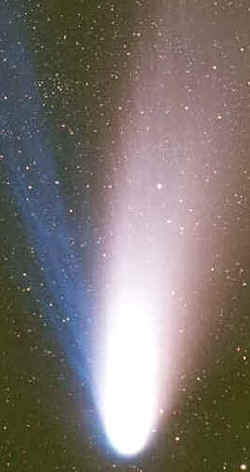Light Crystallizes Ice

Sunlight can melt the snowflakes on your driveway, but light can also create ice crystals, according to research published in the 7 December PRL. A Swedish team demonstrates that ultraviolet light can turn a thin layer of cold, disordered water molecules on a graphite surface into crystalline ice without changing the temperature. They suggest that the photons don’t alter the ice structure directly, but excite graphite electrons, which then enter the water layer. The results may be important for studies of small, cold ice particles, such as those involved in the chemistry of ozone destruction in the atmosphere and in the tails of comets.
Much of the water in the universe is probably in the form of amorphous ice–a noncrystalline state where the molecules are randomly oriented, something like a snapshot of liquid water. Researchers make amorphous ice in the lab by depositing water vapor on a surface colder than about 100 K–at that temperature the molecules stick and lack the energy to rearrange into a crystal. But warm the surface above 140 K, and the ice crystallizes.
Dinko Chakarov and Bengt Kasemo, of Chalmers University of Technology and the University of Göteborg in Sweden, planned to study the effects of light on water mixed with other molecules on surfaces when they noticed the surprising crystallization phenomenon. To analyze it systematically, they created films up to ten layers thick with water molecules on a graphite surface, irradiated them with ultraviolet light, and then studied their structures with two basic techniques. One method uses a mass spectrometer to measure the rate of evaporation of molecules from a surface that is held at constant temperature or gradually heated. Each water molecule in crystalline ice is bonded more tightly to its neighbors than molecules of amorphous ice, so evaporation is slower from the crystalline state. The other method uses an electron beam to scatter electrons from the film and probe molecular vibrations, which signify details of the structure. All of the data suggested that the light transformed the ice structure from amorphous to crystalline at 100 K , just as heating the sample above 140 K does.
Since ice is essentially transparent to the ultraviolet wavelengths they used, Chakarov and Kasemo ruled out any direct effect of the photons on the ice and instead explain their data with an indirect mechanism. They theorize that the photons excite electrons from the underlying graphite crystal, and those electrons quantum mechanically “tunnel” into the ice, depositing energy into individual water molecules and allowing them to rearrange themselves into a crystal. Part of their evidence is that for films more than a few layers thick, the structure of the outer layers was unaffected by the light–just as would be expected, based on the limited tunneling distance of electrons.
Kasemo says the light-induced structure changes could occur anywhere there are small, cold ice particles, such as in the tails of comets and in the atmosphere. John Hemminger, of the University of California at Irvine says the work is “potentially very important” for understanding the chemistry of ozone depletion in the stratosphere. The chemical reactions that produce ozone-damaging molecules are known to occur on tiny ice particles, he says, and the structure of that ice affects the reaction rates. “This adds a new dimension” to an already complicated problem, says Hemminger, because ultraviolet light could potentially excite electrons in the nonwater molecules within these particles and change the ice structure.


